The venerable Kawasaki Versys 1000 has come in for a substantial facelift in 2019. Does the nip, tuck, and pull make for a better bike?
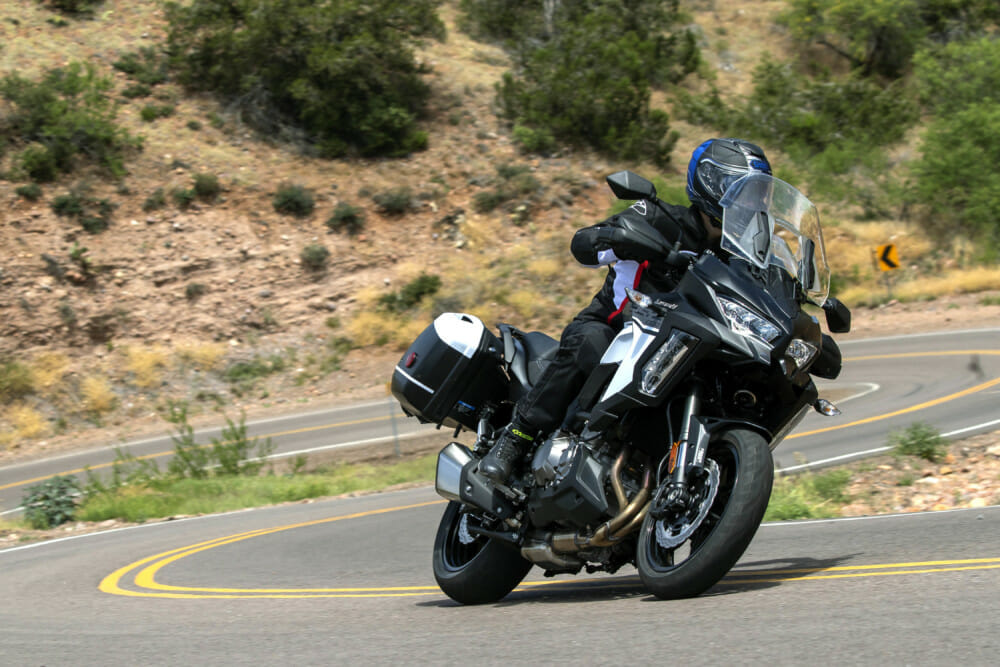
Never has the Kawasaki Versys 1000 been considered the best bike in its class. It’s by no means been a lousy motorcycle, but compared to a few of its more spirited Euro competitors, the Versys 1000 had the performance of a mid-40s balding man who was once a promising track and field star.
For a long time, too, the Versys 1000 was about as old-school as you could get. Electronics like cruise control and a quickshifter were not on the radar, let alone electronically adjustable suspension and ABS and cornering lights.
However, the middle of a new year brings with it a new machine, one that aims to give the Versys 1000 moniker a touch of much-needed style and sophistication to go with its legendary, tax man-like reliability.
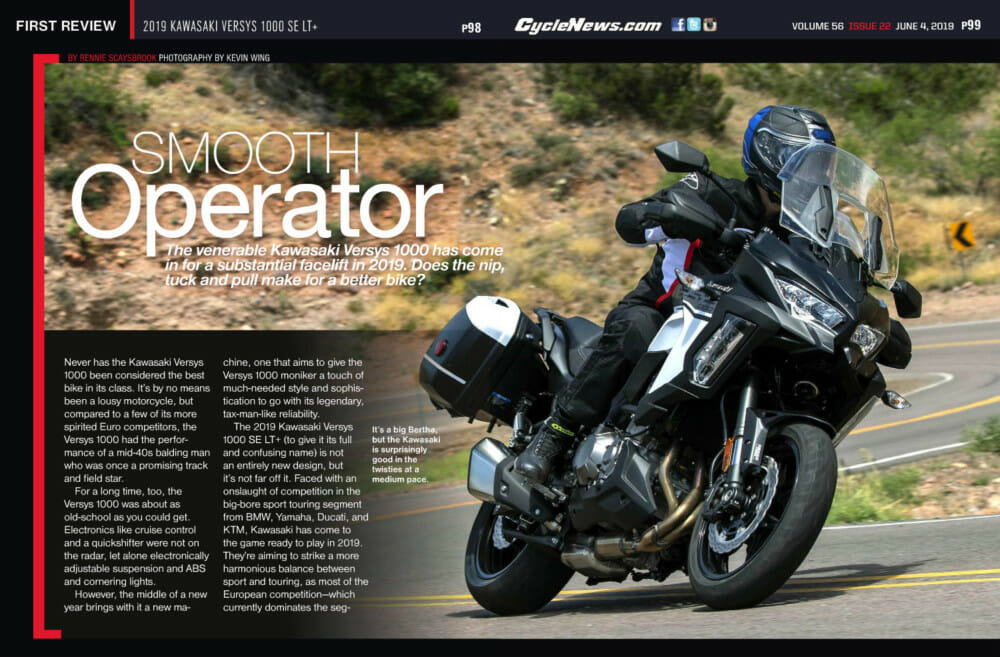
Click here to read this in the Cycle News Digital Edition Magazine.
Photography by Kevin Wing
The 2019 Kawasaki Versys 1000 SE LT+ (to give it its full and confusing name) is not an entirely new design, but it’s not far off it. Faced with an onslaught of competition in the big-bore sport touring segment from BMW, Yamaha, Ducati, and KTM, Kawasaki has come to the game ready to play in 2019. They’re aiming to strike a more harmonious balance between sport and touring, as most of the European competition—which currently dominates the segment—lean much more on the sport side of the equation.
New for 2019 is a whole family of algorithms and acronyms in the Versys—think IMU, KQS, KCMF, KIBS, KTRC, LED, TFT, STHUMHH (Shut The Hell Up My Head Hurts). The most notable of these is the all-new KECS, which stands for Kawasaki Electronic Control Suspension. Developed by Showa and not former partners KYB, KECS consists of the same-as-before 43mm diameter fork and another acronym in the Showa BFRC-lite (Balance Free Rear Cushion) shock, although this one has little wires sticking out the top that allows the ECU to modulate suspension behavior every 10 milliseconds.
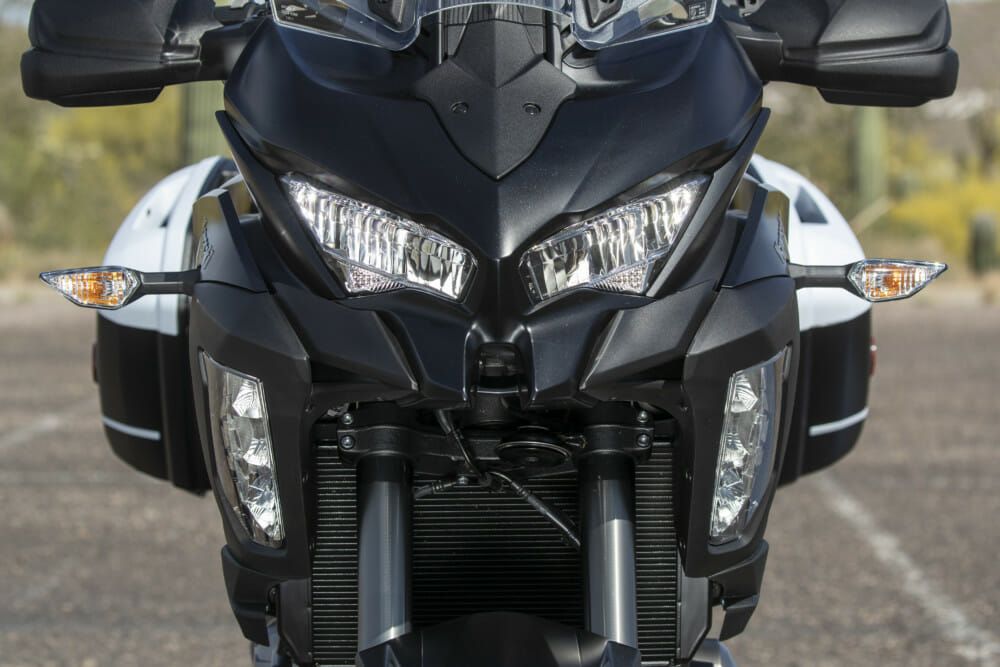
In a similar system to BMW’s Dynamic ESA, the rider can go into the new TFT dash (now with a rather pointless front and rear lean angle sensor) and select preset parameters like rider with luggage, two riders no luggage, etc. However, you can also vary compression, rebound, and preload adjustment levels independently in the new Rider (manual) ECU mode.
Should you want to leave it up to the machine, the Kawasaki system also houses a Sport, Road, and Rain mode that will adjust the throttle response and suspension behavior to the pavement in real time when working with bike speed, suspension stroke speed, and information from the IMU such as pitch, yaw and brake pressure.
When all’s said and done, the Bosch IMU is now the kingpin of the Kawasaki’s behavior. A five-axis IMU, the Bosch system calculates acceleration along longitudinal, transverse and vertical axes; roll rate; and pitch rate, with the sixth axis (yaw) calculated by the ECU.
As such, the new KECS, KTRC (Kawasaki TRaction Control), KIBS (Kawasaki Intelligent anti-lock Brake System), and cornering lights, rely on the IMU for total clarity. The only electronic parts of the bike not directly affected by the IMU input is the new KQS (Kawasaki Quick Shift), heated grips and the new cruise control system.
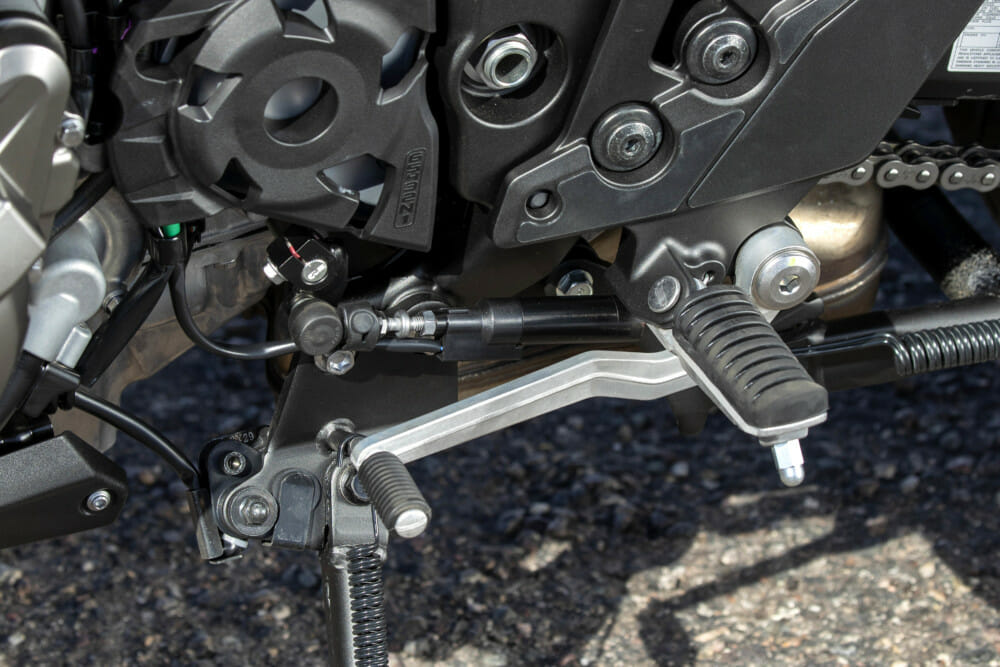
Mechanically, the 2019 Versys 1000 motor is the same 1043cc capacity and six-speed gearbox as before, mated to new ETV’s (electronic throttle valves) and new fuel injection settings for smoother throttle response, especially at low rpm. The exhaust headers 1-4 and 2-3 have been reshaped; there’s a new exhaust catalyzer, and the muffler has been slightly changed.
The chassis is also the same as last year in the aluminum twin-tube design that uses the motor as a stressed member of the chassis, with steel tubing used for the subframe.
One of the big things for 2019—aside from the acronym party—is the fact the Versys 1000 has gone clothes shopping and come back with a whole new look.
It’s clearly been taking styling lessons from the little Ninja 400 and the recently released ZX-6R in that it’s got the sharp nose and LED light set-up, indicating (in my mind, at least) that almost every road-going Kawasaki will look this way in the next few years. What the Ninja 400 and ZX-6R don’t have is the Versys’ cornering lights incorporated into the side of the fairings next to the radiator, giving the rider a far greater illumination of the roadside when leaned over. We didn’t get to test this function thoroughly, so we’ll have to take Kawasaki’s word for it.
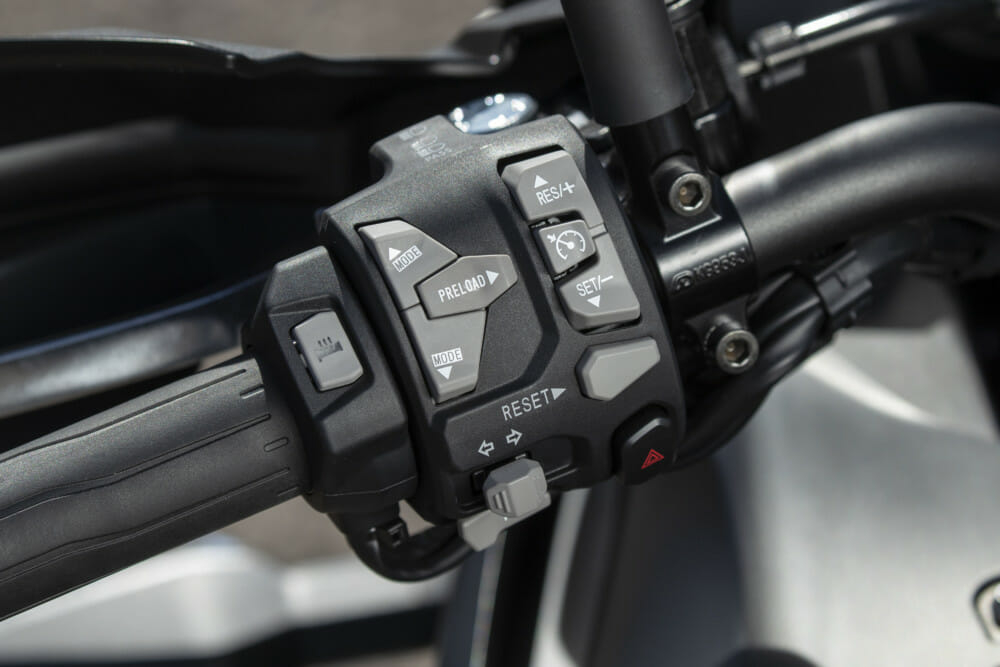
On the bodywork side, you get an adjustable windscreen that isn’t very practical, considering you can’t change it on the fly. Unlike something like the Yamaha Tracer 900, the Versys screen has two securing nuts either side instead of a handle in the center that you could modulate while riding. However, unlike the Yamaha, the Versys’ screen does have a hole about two-thirds of the way down to alleviate low pressure from the oncoming wind, something that works surprisingly well at speed.
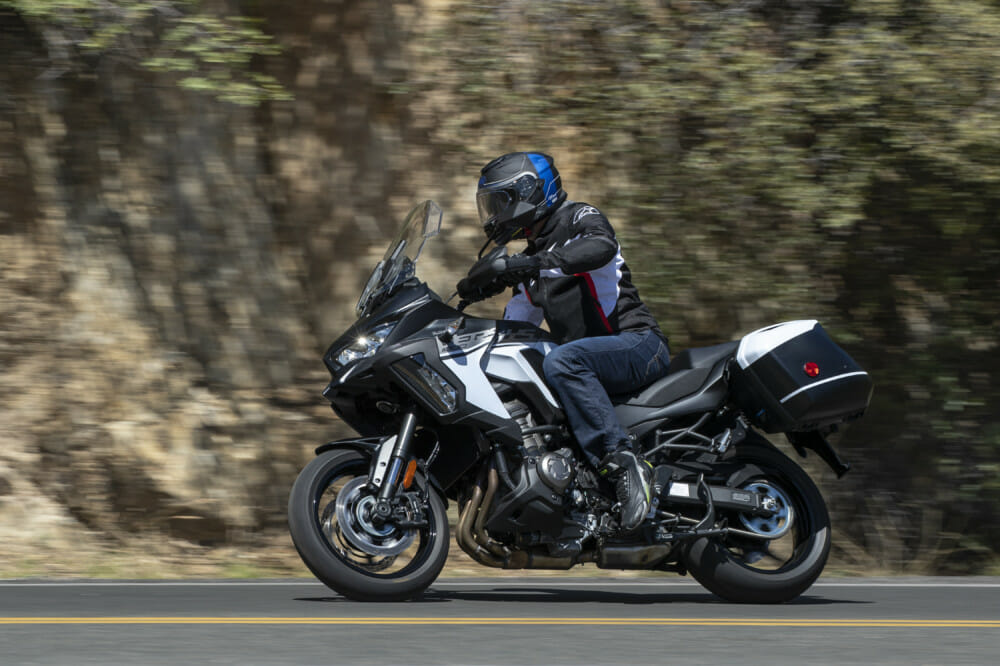
Another area that works well is how nicely Kawasaki has integrated the 28-liter saddlebags you get as standard into the design of the back of the bike. Similar to those found on the big touring daddy in the Concours 14 and rated to store 11 pounds of stuff, they lock with the ignition key, can fit a full-face helmet and a few odds and ends like gloves and scarfs.
At first ride, the Kawasaki feels rather portly. Kawasaki claims this new Versys has gained a rather stout 17 pounds, over the 2018 and there’s no doubt you feel it. Yet, despite the extra weight, the 2019 edition has stability and smoothness the old bike could only dream of.
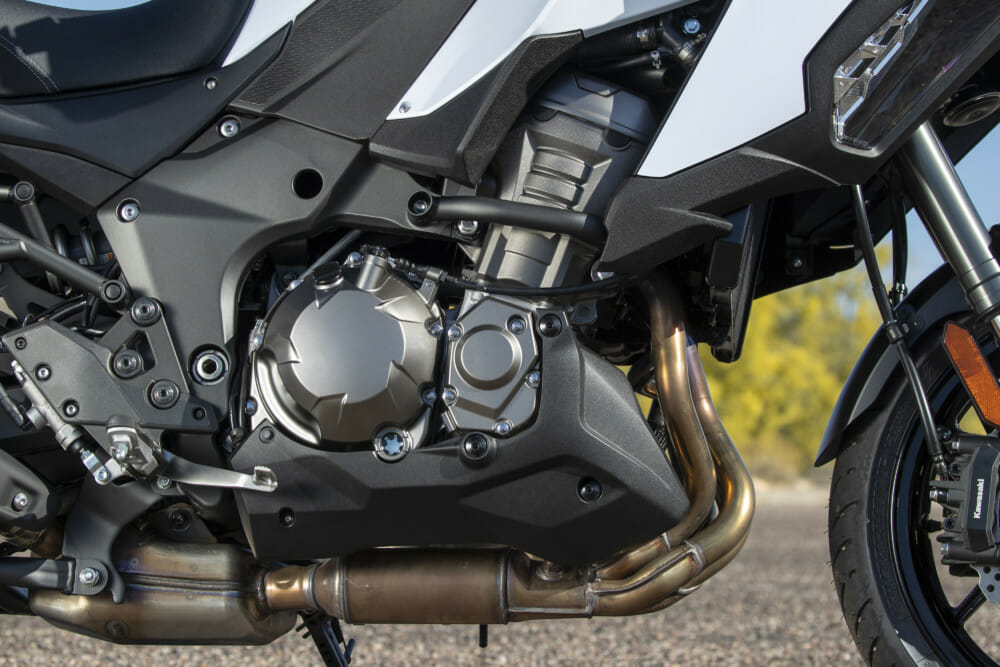
Predominantly responsible for this newfound composure is the Showa electronic suspension, but also the reshaped seat and new ergos. Showa’s done a brilliant job on the suspension action, offering a ride that’s ultra-smooth for long distance trips. This is where the bike shines—compared to something like the KTM 1290 Super Duke GT, the Kawasaki is much more at home making sedate trips than slicing hard through the canyons. It’ll do just that, but not in a “come on, push harder” kind of way. Where I found the best suspension behavior was in sport (so, ironically, with the hardest preset settings), giving the chassis a bit more support under braking and just cruising along, taking in the sights and smells of our two-day loop from Phoenix to Flagstaff, Arizona.
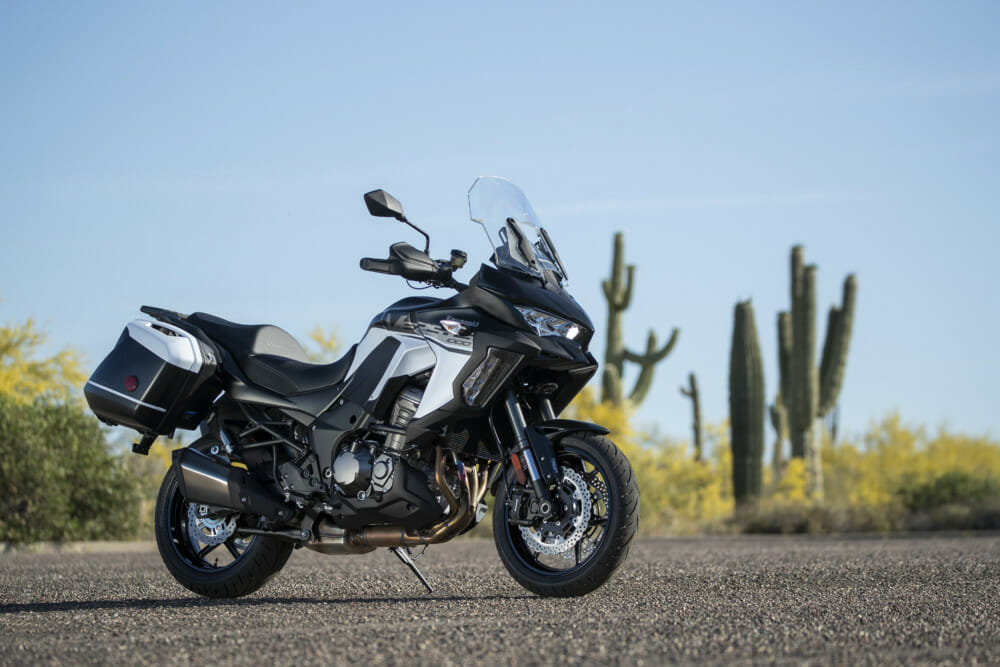
A lot is going on with the new Versys, or rather, there’s a lot that can go on. Ensuring all the various electronic systems are easy to access and use is no simple task, but the new TFT dash and switchblock on the left bar does a good job of something many manufacturers stuff up.
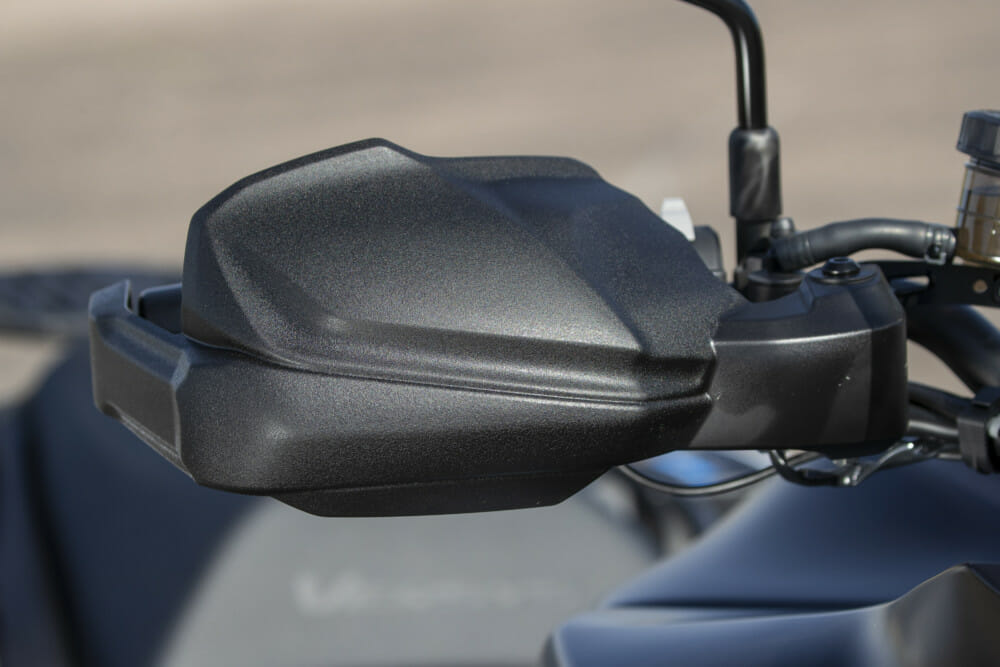
And better yet, Kawasaki’s developed their own app called Rideology, one that allows you to pair your phone to your bike and log everything from where you went, how far, lean angle, fuel mileage, etc., and then go into the bike’s ECU and mess around with your maps, suspension settings—you name it. Check out the attached video for a proper demonstration.
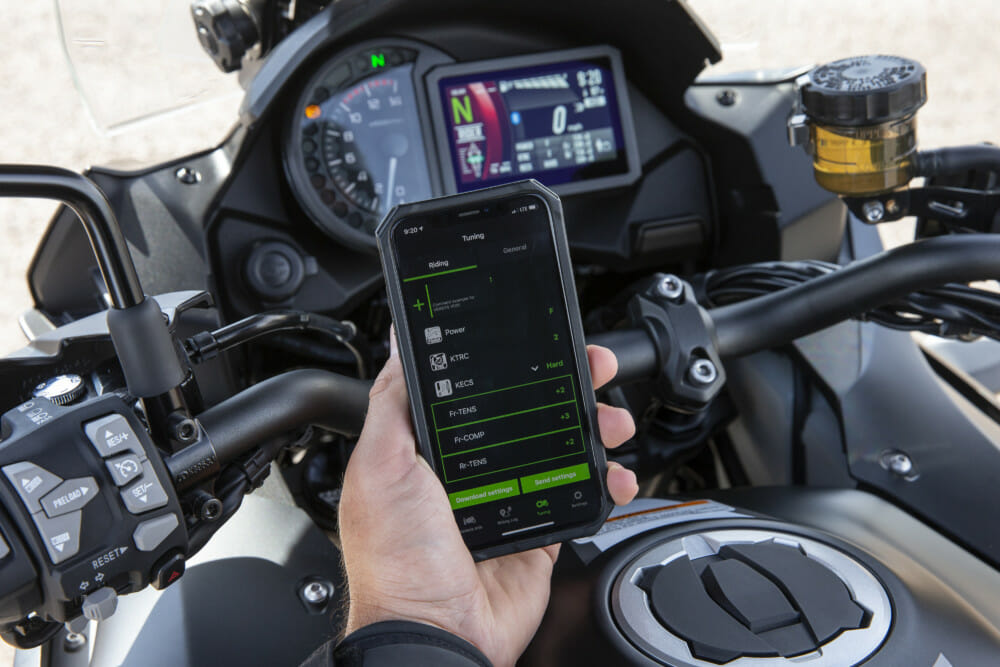
Running the app will suck the life out of your phone, as it’s drawing data from both GPS and the bike itself, but Kawasaki’s fitted a class-standard 12V power outlet next to the dash that you can connect your phone to. The app doesn’t do turn-by-turn navigation, so if you want that you’ll still have to run Google Maps (or whatever nav app you like). If you’re a cyclist, you’ve no doubt heard of Strava, and this Rideology app is pretty similar in application.
VIDEO | Rideology, The App
Anyway, back to the bike.
Straight up, the 1043cc inline four-cylinder motor, derived from the now-defunct Z1000, can’t hold a candle to class competitors like the BMW S 1000 XR or the Super Duke GT. It’s got plenty of power to get you out of any situation, all metered by a delightfully smooth throttle response, but if it’s outright power you want, look elsewhere. Hard acceleration can feel labored, the motor instead preferring a smooth, cruisy application of the throttle (see a theme developing here?). Midrange torque is very good, and if you keep the motor spinning between 4500 rpm to 7000 rpm in the twisties, you’ll hardly need to shift gear.
Also, the new quickshifter isn’t the smoothest in operation below 4000 rpm. The Kawasaki system has a longer ignition cut out than I’d have liked, insisting on a wide open throttle with the revs surging for the ultimate performance. It is operational in the both up and down shift, mind you, so that’s a good thing to have in the Versys arsenal.

In all, the 2019 Kawasaki Versys 1000 SE LT+ is an excellently executed machine, with pretty much every bell and whistle the touring rider could want, but lacks the kind of pizzazz some of its competitors offer. Having not put 200,000 miles on one, I cannot comment on the 2019 edition’s reliability, but if past versions are anything to go by, long distance riders will be fine in that regard.
Unlike the Kawasaki H2 and H2 SX that overflow with it, the Versys 1000 lacks engaging personality. It doesn’t scream at you to get on and ride, even though it’s undoubtedly one of the best bikes under $19,000 with which to cover massive miles, especially considering the excellent new electronics suite.
However, if that stuff doesn’t matter to you, and all you want to do is get on and ride till the sun dips under the horizon, the new Versys is your bike.CN
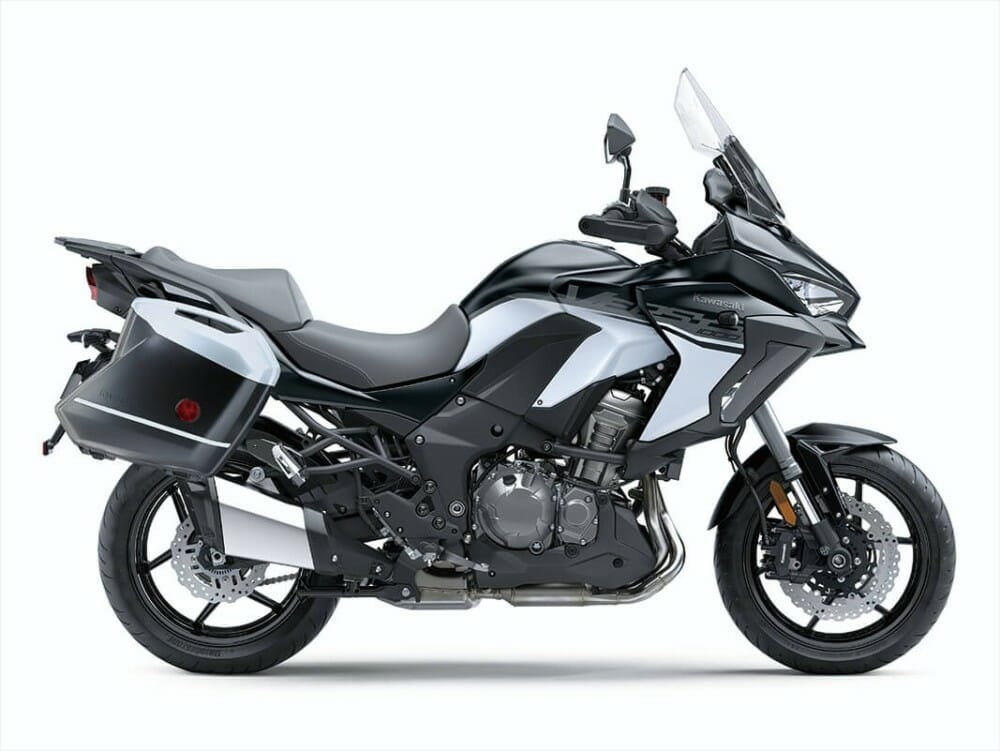
2019 Kawasaki Versys 1000 SE LT+ Specifications
| MSRP: | $17,999 |
| Engine: | DOHC, 4-valve, inline, 4-cylinder |
| Displacement: | 1043cc |
| Bore x stroke: | 77 x 56mm |
| Compression ratio: | 10.3:1 |
| Fuel system: | EFI |
| Torque: | 75.2 lb-ft at 7500 rpm |
| Exhaust: | 4-2-1 |
| Clutch: | Wet multi-plate |
| Transmission: | 6 speed |
| Chassis: | Cast aluminum double cradle |
| Front suspension: | 43mm Inverted Fork with KECS-controlled compression and Rebound Damping and Manually-Adjustable Preload |
| Rear suspension: | Horizontal Back-link, KECS-controlled compression, and Rebound Damping and Electronically-Controlled Preload Adjustment |
| Front Wheel Travel: | 5.9 in. |
| Rear Wheel Travel: | 5.9 in. |
| Front brake: | Dual 310mm discs, dual 4-piston Monobloc calipers, Bosch Cornering ABS |
| Rear brake: | 250mm disc, 2-piston caliper with Bosch Cornering ABS |
| Front tire: | 120/70 R17 |
| Rear tire: | 180/55 R17 |
| Wheelbase: | 59.8 in. |
| Seat height: | 33.1 in. |
| Fuel capacity: | 5.5 gal. |
| Weight (claimed, wet): | 566.7 lbs. |
Click here to read this in the Cycle News Digital Edition Magazine.
Click here for the latest Cycle News Sport Touring motorcycle reviews and news.
Click here for more Kawasaki motorcycle reviews and news.
